Indigenous Mound Magic
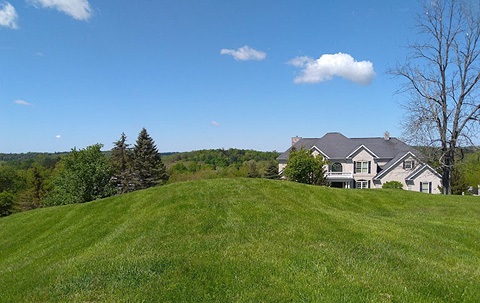
Not far from Newark and high above the town of Granville, Ohio is a 200-foot long Native earthwork called Alligator Mound. Researchers believe the effigy isn’t an alligator at all but an “underwater panther” – a powerful cat-like water monster covered in reptilian scales.
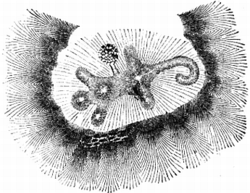
Map of Alligator Effigy Mound
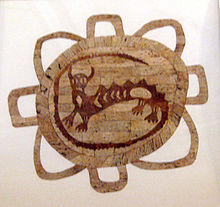
The Underwater Panther (aka “Mishipeshu”): A water monster that exists in opposition to the Thunderbird.
To see it, you must travel up a long and winding road and through a modern-day subdivision. The large earthwork is at the apex where you also find an incredible vantage point. Through the leaves and trees you can see sections of the valley below and if it were were clear of foliage you could see around for miles.
The affluent subdivision reminds me of the seemingly innocuous settings used for early 80’s horror films like Poltergeist. Upon reaching the top, another scary movie comes to mind, Pet Semetary (see short film clip and full movie based on the novel):
Like the lead in the film, I was amazed by the pre-Colombian site.
“What is this place?” and “What did they do up here!?”, I wondered. The site was both eerie and striking!
“The barrier was not made to be broken. Remember this: There is more power here than you know. It is old and restless.”
– A dream-like warning to Louis, the main character in Stephen King’s fictional novel, Pet Semetary.
Part of the takeaway I get from Pet Semetary is don’t mess with magic you don’t understand – especially where a potential for horror exists! The main character in the novel ignores a warning from beyond the grave and suffers accordingly.
Of all the novels he has written, Pet Semetary frightens Stephen King the most but we know it’s only fiction. Part of the value of such fictional stories is they remind us there is a hidden history to our surroundings. King likely heard of legal battles between native and New England land authorities in the 1970s. There are haunted history writers such as Colin Dickey, who suggest that native-related ghost stories are emerging because modern Americans are experiencing an anxiety over land ownership (1).
Manhattan was bought from the natives for beads, trinkets and goods worth 60 coins. Most of the continent was simply appropriated. As reprehensible as that is, I suspect there is more to the Native American ghost story than feelings of guilt. Some of the ancient places resonate with “power”.
The first owner after statehood, Rachel Brown, lived in a cabin near what is now known as Craig Mound. She told of mysterious sounds and of blue flames emitted from the mound at night, and of mules that were spooked around the structure”. – From 405 magazine, The Treasure of Sprio Mounds by M.J Alexander, 405 Magazine
Newark Earthworks
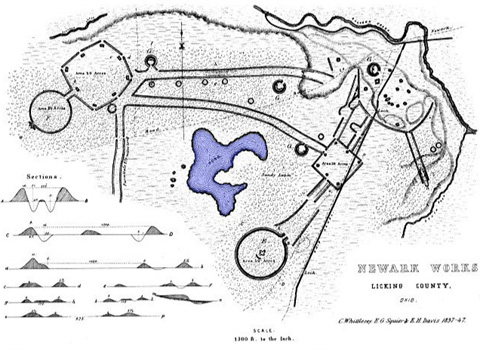
Since learning of Greg Little’s monumental study of ancient American Earthworks (see See Greg and Lora Little Article), I have become fascinated with the history of ancient America and started visiting indigineous sites. One place I wanted to see in particular was Newark, Ohio.
A seven or so mile drive from Alligator Effigy Mound, the Newark Earthworks are the largest geometric earthwork complex in the world. In terms of scale and work involved, the earthworks are said to rival the Giza complex of ancient Egypt. They extend over two square miles and scientists have confirmed the builders must have had an advanced knowledge of astronomy as the octagon and circle Earthworks are an observatory that track lunar movements:
“When viewed from the observatory mound, the moon rises at that time within one-half of a degree of the octagon’s exact center. The earthwork is twice as precise as the complex at Stonehenge”(2).
“This is one of the few sites in America that is pristine!” – Greg Little on Octagon lunar observatory earthwork at Newark, Ohio. (from https://www.youtube.com/watch?v=AxZ8cgoqtsg at 51:45).
Amazingly, few people are aware of the site. Although the Great Circle and Octagon are pristine and still there, much of the two-square-mile Newark works have been destroyed to make way for the modern city. Thanks to a creation of a state park and the “Mound-Builders Country Club” – a golf club that keeps the octagonal and circular earthwork as part of the course – developers have been unable to bulldoze what’s left.
I take photos but it is difficult to relay or represent the immense scale of the Newark earthworks. One must see it in person. Photos often look like grassy parks and hills. You can tell people that the great circle is 30 acres and several times larger than a football field but this means little if they can’t really envision it.
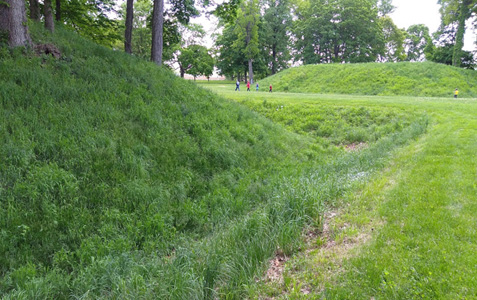
Entrance to the Great Circle Earthwork. This Newark, Ohio earthwork encompasses an embankment that has a moat on the inside. Close to center, the visitor finds an eagle effigy. The circular construction complete with inner moat is similar to a Neolithic henge. Consider for example, Woodhenge near Stonehenge. Water in the ditch of such Native American earthworks is thought to act as a barrier to the dead and protection from supernatural forces (6). Alternatively, bodies of water can act as a portal to the underworld in multiple ancient cultures.
A modern person can only imagine the scale of rituals once held here. Across North America, there are literally thousands of sites that were gathering places for ancient ceremonies. Energy and effort would be spent to honor ancestors, protect sacred places and conjure powerful spirits. Perhaps the ceremony also protected the community from powerful spirits:
“America is not a young land: it is old and dirty and evil. Before the settlers, before the Indians… the evil was there… waiting.”
― William S. Burroughs
Visiting the Newark site, I begin to wonder if there exists a connection between sacred sites and paranormal happenings. Some buildings close to the Newark Earthworks and Alligator Mound are said to be haunted. For example, within walking distance from Alligator Mound is the Haunted Bryn Du Mansion. In Newark, paranormal investigators have often visited the Licking County Jail where phenomena varying from strange mists to disembodied screams are encountered (3).
Connections to the Spirit World

“The Conjuror” by G. Veen, 1590
In a recent trip to a recreated indigineous village in Cuba, I learned the Taino community elders spent much time in drug-induced states trying to communicate with supernatural entities. In this sense, magic was a tool to serve the needs of the community as the elders sought guidance, possibly to indicate good places for hunting or warn of attacks from enemies. This necessitated the opening of portals to other worlds via drug-taking and trance; a sort of consciousness technology few modern-day people would understand.
Any sufficiently advanced technology is indistinguishable from magic”.
– Arthur C. Clarke
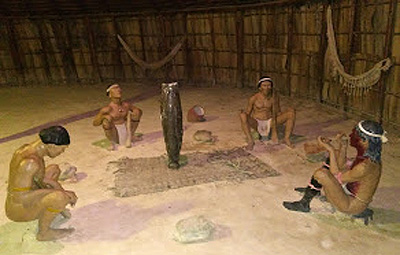
Recreation of Native community leaders in ritual contact with the Supernatural, Campina Taina, Cuba
Agricultural cycles have often been linked to stone circles and neolithic calendars. It is widely believed such calendars indicate the best time to plant and harvest crops. Another possibility, is the extremely large octagon and circle earthwork in Newark might have served as a clock to indicate the best time for ritual.
Is it possible that phases of the moon had an impact on the effectiveness of Hopewell magic?
More research is required but some early studies of the moon and psi seem to indicate relationships between heavenly bodies and paranormal abilities. (For example, see this paper on the Solar-Periodic Moon Effect).
Was it important to perform rituals during specific phases or positions of the moon?
Ohio Valley Adventure
Beginning in the late 1700s, settlers from the Eastern states migrating to the Ohio Valley found hundreds of mounds and earthworks. The Shawnee and other American Indian peoples apparently knew little of the builders. Many tried to solve the mystery of the mounds”.
– Hopewell Culture Brochure, National Park Service, U.S. Department of the Interior
Ohio and the American heartland are full of wonders like the Newark octagon yet these places receive very little attention in the mainstream media. Upon telling friends I was traveling to Ohio for a short trip they asked, “what’s in Ohio?” They really had no idea about the collosal Earthworks and I have to confess, neither did I until hearing one of Greg Little’s lectures.
It turns out that Ohio is a very attractive state, full of green woods, rolling hills and big old trees. After visiting Granville and Newark, I wanted to see the Serpent Mound Historical site but noticed my car was having trouble. The next major city was a place called Chillicothe where I learned a place called “Mound City” was located. Once in town, the man at the muffler shop told me I should find a dealership to get the part I needed but there was no such dealership for hundreds of miles. A quick search on my cell phone revealed there was a dealership in Parkersburg, West Virginia, a place I planned to visit anyway. I could still drive the vehicle so decided to risk going but before heading out, I visited “Mound City” at Hopewell Culture National Historical Park.
They have a museum onsite and upon entering I was invited to sit and watch a documentary about the park and Hopewell mound builders. Afterwards, I went into the museum to have a look at the well-crafted artifacts attributed to the Hopewell:

Photo by http://www.nps.gov/hocu/indepth.htm, Public Domain, https://commons.wikimedia.org/w/index.php?curid=487082
Back at the gift-store, I bumped into a elder gentleman who said he was the president of a mound protection society in Ohio. He handed me a brochure about mound city along with some maps.
I remarked on how one of the maps showed the burial mounds following the course of the river and I had observed a similar pattern with the ancient cairns at Kilmartin in Scotland, a place I had visited only a year earlier. The society President thought this was due to the perception that rivers attract all life and the natives wanted their ancestors to be close to the source of water, or, source of life itself. Even though car problems and worries were on my mind, I could not help but feel very lucky at the chance meeting of this man in a sacred place that had not been on my original itinerary!
It turns out the earthworks in the Newark and Chillicothe sites are connected by the “Great Hopewell Road”. This 60 mile road is “160 feet wide with walls 4-6 feet high and 40 feet wide” according to Dr. Little who is describing the road remnants near Newark (see https://www.youtube.com/watch?v=AxZ8cgoqtsg at 53:00).
From the Hopewell park, I continued to Point Pleasant, West Virginia to spend the night. John Keel has been very influential in my investigations and he made Point Pleasant his second home (see my post on Keel). Although I never crossed paths with the Mothman, I enjoyed seeing his statue up close:
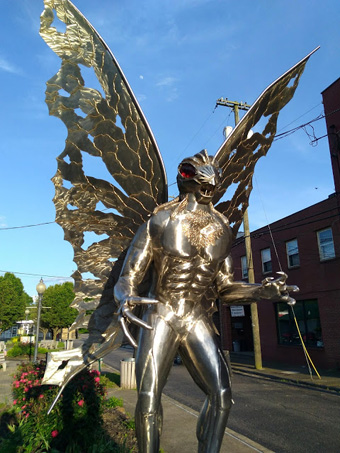
The Mothman Statue, Point Pleasant, West Virginia
Some speculate there is connection between Mothman and the mysterious figure known as “Indrid Cold”, who landed his UFO one night in 1966 on the road just outside Parkersburg and had a telepathic conversation with a salesman named Walter Derenberger. This bizarre case attracted national media attention and an interview with Derenberger is available on Youtube.
On my way to Parkersburg the next morning, I saw the ominous cooling towers of a nuclear power station close to the Ohio river. I wondered what archaeologists of the far future will say after they dig this monstrosity out of a dirt hill millions of years in the future; “it was a strange kind of magic they employed and quite dangerous”!
I mused that the Mothman might be a far-future highly evolved, time-traveling archaeologist who is trying to make sense of different time lines while also attempting to warn ancient people of impending disasters. Of course, I can’t really say what “he” is. I can only guess the Mothman might be related to the winged angel-like Sumerian Anunnaki-like beings represented in art-work since ancient times.
At Parkersburg, the dealership clerk told me I had to wait 2 weeks for the next appointment. I asked if there was another local repair shop that could help. The place he sent me had a parking lot full of cars to be fixed and a very tired-looking mechanic. I went inside the office anyway. Fortunately for me, the receptionist was busy on the phone and so the owner came out of his office to speak with me. After learning I was far from home, he took my car for a spin to investigate the problem.
A very kind man, the owner soon realized another shop could fix my exhaust and called them on my behalf. Later that afternoon, I was back on the road with the new part installed and other fixes welded in place.
I would have to see Serpent Mound another time but the experience of meeting a mound protection leader and other good people like the auto repair shop owner was well worth the diversion!
The Ghosts of Moundsville
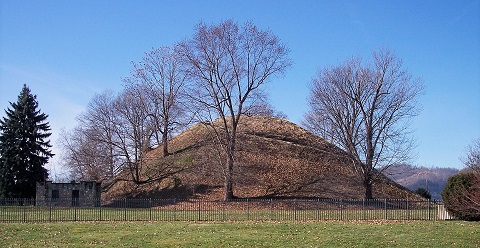
By Tim Kiser (User: Malepheasant) – Self-photographed, CC BY-SA 2.5, https://commons.wikimedia.org/w/index.php?curid=1725430
The Grave Creek Mound is one of the the largest mound structures in the United States standing at 62 feet and once at least 69 feet in height (see Grave Creek Mound). There are multiple native burials at different levels and some of the artifacts found are on display at the site museum. It is attributed to the mysterious Adena culture who are said to predate the Hopewell. In the 1800s, the mound was dug into by treasure hunters but prison labor was later used to fill in the holes.
Just across from the mound is the former West Virginia Penitentiary where inmates once lived in appalling conditions. Understaffed and overcrowded, the place has a vile history. Today, the building is a tourist attraction and reputed to be haunted. Tourist attractions involving ghosts are always suspect but this one has the attraction staff spooked with objects moving by themselves, ghostly noises and a “shadow man” figure showing up in at least one photograph (4).
Is there a connection between the sacred site of Indian burial and a haunted penitentiary, or, is the prison simply haunted by its own vicious past?
It is very difficult to investigate such questions. The paranormal researcher is dealing with a “hidden” reality. Even when researched in controlled laboratory conditions, the cause of paranormal activity is elusive and experimenters can only identify patterns and correlations. There seems to be a connection between sacred sites and the paranormal but it can be almost impossible to establish what is causing the weirdness. For example, there could be a third or intervening variable.
It might not be the spirits of ancient Americans but something about the site itself; the presence of leftover magic or perhaps some kind of environmental factor that makes such places into power spots and portals to otherworldly realms. These places might play host to all kinds of energies and entities, where either good or evil can exist in abundance.
Hauntings and Poltergeists in Ontario, Canada
“It is widely believed that Cherry Hill House is located on an Indian Burial Ground and that this accounts for the series of disturbances noted for over two decades”.
“A common motif has it that a house is haunted because it was erected on the site of an Indian Burial Ground. The motif is widespread. The subject is difficult to research, as there is no registry of Native burial grounds”.
– John Robert Colombo, Canadian Folktale Chronicler in his book Mysteries of Ontario, Hounslow Press, 1999, page 150 and 26,
A ghost story told in Ontario reminds me of the horror film, Poltergeist (1982): A newer Mississauga, Ontario suburban home is said to have been built on the edge of an ancient Indigenous burial ground. In the evening, an unknown green-colored light will shine into the windows at the back of the home. The family (especially the children) claim to have seen the face of an elder staring in at them at night, with the implication being that he is the shaman protector of the burial ground.
Stories like this are hard to confirm as there is no home address given or official record. It might just be an urban legend. As Canadian researcher John Robert Colombo points out, the haunted home built on the native burial ground has become a cultural motif.
Sometimes, the connection between ancient native locales and hauntings is tenuous at best. But what if there exists a connection and what do the aboriginal people think of all of this?
Developers and the Haunting of Chain Stores
While researching this post, I have come across article after article describing the destruction of native archaeological sites. It looks like strip malls and chain stores might be next in line for a paranormal horror show. Developers for the Walmart chain have been accused of being indifferent to sacred sites and native burials (5). A video about one such controversial case can be viewed here:
The destruction of native archaeological and sacred sites is horrendous on many levels. Not only are developers being disrespectful to the ancestors of this land, they are messing with things they don’t understand.
Developers just flatten places and build our modern chains, prisons and high priced subdivisions without knowing or accepting the consequences. Maybe, the land has gone “sour” in these locales and without the former keepers, the evil mentioned by both King and Burroughs has returned.
Native paranormal researcher Tonya Whitefawn speaks of the need to “cleanse” the Earth and deal with “supernatural beings”:
As a Native, we have a natural ability to connect with the Earth and its energies. When we began cleansing the land we also helped Spirits move on, we got so much activity we began filming to capture our journey and discovered these other Supernatural Beings had made themselves known to us and these clips are some of these creatures, proving that they are real and under our very feet, you will even see the Demon that even gave us it’s name at the end of the clip, to see the difference between Elementals and Demon. Through our history and tradition, these beings have been known to help tribes, it is our job now to heal the earth, just as these beings have been known to help the earth and the people…” – Tonya Whitefawn, Native Paranormal Seekers (from Native Paranormal Seekers on Youtube)
The exploration of Native sites will be continued in part 2. For now, have a listen to the Cult (-AJB):
Notes
1. See “Ghostland: An American History in Haunted Places” by Colin Dickey, Penguin Random House, 2016. Pg. 45.
2. See https://en.wikipedia.org/wiki/Newark_Earthworks#Octagon_Earthworks.
3. See Licking County Jail
4. See Moundsville Prison
5. See Wal-marts History of Destroying Sacred Sites
6. See Ghosts, Water Barriers, Corn, and Sacred Enclosures in the Eastern Woodlands Robert L. Hall American Antiquity Vol. 41, No. 3 (Jul., 1976), pp. 360-364:
“Ethnographic accounts indicate that in historic times the belief was widely held in the United States that ghosts could not pass through water and that the geometry of a circle was effective in countering magic or supernatural forces”.